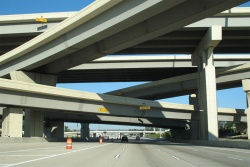 Interstate 10 at the Interstate 610 Loop in Houston, Texas. Photo courtesy HoustonFreeways.com. Click image to enlarge |
By Bill Vance
It is hard to imagine the United States without its interstate highways, the 68,600 km (43,000 mi) of limited access, multi-lane divided expressways that can carry passengers and commerce coast to coast and border to border without a single stoplight. It’s been called the greatest civil engineering project in the world, larger than the Great Wall of China, the Egyptian Pyramids or the Panama Canal.
Authority for the interstate system was the Federal-Aid Highway Act of 1956 signed by President Eisenhower on June 16, 1956. Officially the Dwight D. Eisenhower System of Interstate and Defence Highways, it became known simply as the Interstate Highway System.
The Act fulfilled a dream of the President since 1919 when as a 28-year old lieutenant he participated in a post-First World War motorized military convoy to highlight the terrible condition of U.S. roads. They followed the Lincoln Highway that ran from New York to San Francisco, the approximate route of today’s Interstate 80.
By the end of the trip, the toll of collapsed bridges, mired vehicles and personal injuries convinced Eisenhower the nation sorely needed a good highway system. This was further reinforced during the Second World War when, as Supreme Commander of the Allied Forces, Eisenhower was highly impressed by how efficiently Germany’s Depression-project autobahn highways moved troops and equipment around the country.
The interstate system was a federally sponsored program which the states could join voluntarily. Since the U.S. Government’s reimbursement of 90 per cent of the cost was a strong inducement, of course they all participated. Existing toll roads like the Pennsylvania Turnpike were incorporated, and approximately five per cent of the system is tolled.
Engineers and construction crews started quickly, and before the end of 1956 the first pieces of intestate were completed. Standardized materials and configurations were enforced throughout. It was to be a limited access highway with a minimum of two 3,658 mm (12 ft) wide lanes in each direction. Although engineered for 112 km/h (70 mph), it could accommodate more. Indeed, some states like Nevada and Montana had no speed limit at all, asking motorists only to drive in a “reasonable and proper” manner. Curves were gentle and banked and the highway was as smooth and straight as terrain allowed. Realizing the hypnotic affect interstate driving could have, rest stops were usually planned about 56 km (35 mi) apart.








